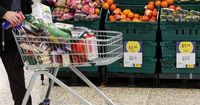Price rises in the U.K. moderated more than anticipated in February, providing a welcome boost for Treasury chief Rachel Reeves ahead of her crucial statement to lawmakers regarding the state of public finances. Official figures released on Wednesday, March 26, 2025, by the Office for National Statistics revealed that consumer price inflation fell to 2.8% from 3% in January, surpassing analysts' expectations of a more modest decline to 2.9%.
The significant drop in inflation was primarily driven by a decline in clothing prices, particularly women’s clothing. This change in the market has raised hopes for consumers, even as inflation levels remain above the Bank of England’s target of 2%.
Despite the positive news, the cost of living continues to rise for households across the U.K., reflecting the ongoing economic challenges. Last week, the Bank of England opted to maintain its main interest rate at 4.50%, even as the economy shows signs of stagnation and uncertainty looms due to tariff policies enacted by the Trump administration in the U.S.
Reeves is expected to deliver her spring statement later in the day, where she will likely announce spending cuts across some government departments. This comes in response to weaker economic growth projections from independent forecasters, who have expressed concerns over the sustainability of the current economic environment.
In a related development, the fall in inflation has also influenced the currency markets. The British pound fell slightly against the U.S. dollar, while two-year British government bond yields, which are sensitive to speculation about interest rates, dropped by nearly seven basis points, marking their largest daily decline in almost two months.
However, economists caution that the relief provided by the recent inflation figures may be short-lived. Suren Thiru, Economics Director at the accountancy body ICAEW, warned, "February's slowdown is a false dawn as notable near-term price rises are already baked in, with next month's jump in energy bills and national insurance likely to push inflation perilously close to 4% sooner rather than later." This sentiment underscores the volatility in the current economic landscape.
Looking ahead, some economists speculate that the Bank of England may consider a rate cut in May, although others urge caution. Luke Bartholomew, deputy chief economist at investment firm Aberdeen, noted that while the latest data does not fundamentally change the inflation outlook, it could pave the way for another interest rate cut in the near future.
As the Bank of England grapples with these challenges, it has projected that consumer price inflation could peak at 3.75% in the third quarter of this year, driven largely by rising energy costs and regulated tariffs for household utilities and transportation.
Despite the overall inflation decline, services inflation remained steady at an annual rate of 5.0%, contrary to expectations for a decrease. This figure is particularly significant for the Bank of England, which closely monitors services inflation as an indicator of economic health.
James Smith, an economist at ING, commented on the services inflation data, stating, "It should still fall back in the second quarter, though, keeping the Bank of England on track for three further rate cuts this year." This perspective highlights the ongoing debate among economists regarding the trajectory of inflation and the appropriate monetary policy response.
As the government prepares to navigate these economic challenges, the focus will be on how Reeves articulates her strategy in the spring statement. With the backdrop of fluctuating inflation rates and economic uncertainty, her decisions will be closely scrutinized by both lawmakers and the public.
The recent inflation figures, while encouraging, serve as a reminder of the complexities facing the U.K. economy. As consumers continue to feel the pinch of rising costs, the government's response will be pivotal in shaping public sentiment and economic stability in the months to come.




